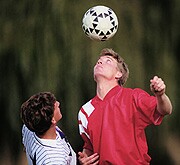
FRIDAY, Aug. 27 (HealthDay News) — Your child takes a hard hit during a football game. Or a nasty fall caused by a failed cheerleading stunt.
The youngster gets right back up but stumbles around a bit and seems to be only dimly aware of his or her surroundings. A worried teammate tries to converse, but you can tell from the sidelines that your child is having a hard time understanding what’s being said and appears sluggish, dazed and confused.
Chances are that the child sustained a concussion. And if parents and coaches don’t know how to recognize the signs and pursue prompt treatment, the child could be at increased risk for a severe brain injury, with lifelong consequences.
“If a concussion goes undiagnosed, it can increase the risk of re-injury,” explained Dr. Paul Gubanich, an orthopedic specialist in the Center for Sports Health and the orthopedic surgery department at the Cleveland Clinic. “We know repeated head injuries can lead to chronic changes in the brain. Athletes who go back to play before they are fully recovered are at risk for having worse symptoms and more prolonged injuries.”
A concussion occurs when the brain sloshes around inside the skull because of a blow to the head. The brain is cushioned against minor head trauma — think a slight bump on the noggin — by spinal fluid that surrounds it inside the skull. But a heavy impact can actually cause the brain to smack into the bone of the skull, causing bruising of the brain, torn blood vessels and nerve damage.
Because they are still developing, children and teens are more likely to have a concussion than adults, according to the U.S. Centers for Disease Control and Prevention. It also takes youngsters much longer to recuperate.
Each year, emergency rooms in the United States treat an estimated 135,000 youths 5 to 18 years old for sports- and recreation-related traumatic brain injuries, according to the CDC. Concussion causes the vast majority of those injuries.
But don’t think that those concussions were all due to contact sports. Football and soccer injuries are common, but other activities associated with traumatic brain injuries include bicycling and playground activities, the CDC reports.
Even cheerleading, with its increased emphasis on wild stunts, has become a rising cause of concussion. “I’ve seen a lot of them getting a concussion from someone not catching them during a stunt or from a misstep taken during a tumble,” said Dr. Robert Agee Jr., a sports medicine physician at Lemak Sports Medicine & Orthopedics in Birmingham, Ala., and a spokesman for the National Center for Sports Safety.
Concussions can be tough to detect. There are no outward signs of concussion, and symptoms, which sometimes appear right away, can also be delayed for days after the injury. Even doctors struggle to detect concussions because normal brain scans, including MRIs and CT scans, cannot pick them up with any degree of certainty, Agee said.
“You can’t see a concussion. You can’t feel it,” Agee said. “You just know it from symptoms and how the person’s brain is processing information.”
After a child has sustained a hard blow to the head during sports or play, parents should be on the lookout for concussion symptoms. For instance, a concussion might have occurred if a child:
- Appears dazed or stunned
- Moves around clumsily and has problems staying balanced
- Answers questions slowly
- Loses consciousness, even for a moment
- Seems confused about where he or she is or what he or she is doing
- Has trouble remembering things that happened either before or after the blow
- Is behaving strangely or out of character
- Complains of a headache
- Suffers from nausea or vomiting
- Is sensitive to noise or light
- Reports blurry or double vision
Any of these signs should cause concern, expert say, and should prompt parents and coaches to seek medical attention for the child right away.
A child who’s been diagnosed with a concussion needs to stay away from sports for as long as it takes the brain to heal. Research has found that a brain recovering from concussion is susceptible to increased injury if a second head injury occurs.
“The brain is already compromised by the first hit,” Agee said. “Your brain is already vulnerable, and you’re susceptible to having a concussion again with very minimal trauma if you go back too soon.”
Brains that undergo repeated concussions are at increased risk for memory loss, cognitive problems, chronic headaches, epilepsy and eventually Alzheimer’s disease, said both Gubanich and Agee.
To help protect children, make sure they wear the proper safety equipment for whatever sport they’re playing. If they need a helmet, make sure it fits properly and the kids are using it as instructed. For example, if a chin strap is included, it should be worn.
Training also plays a role in concussion safety. Health experts agree that kids should learn from a coach who focuses on the fundamentals of play. As Agee said, children who know the proper stances and moves for their sport are less likely to be injured during play.
More information
The U.S. National Institute of Arthritis and Musculoskeletal and Skin Diseases offers a parent’s guide to preventing sports injuries in children.
For more on head injury risks, read about one teen’s story.

